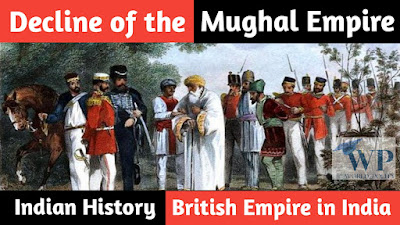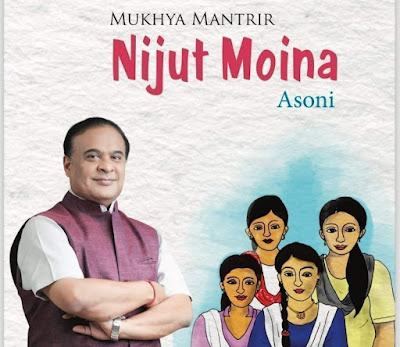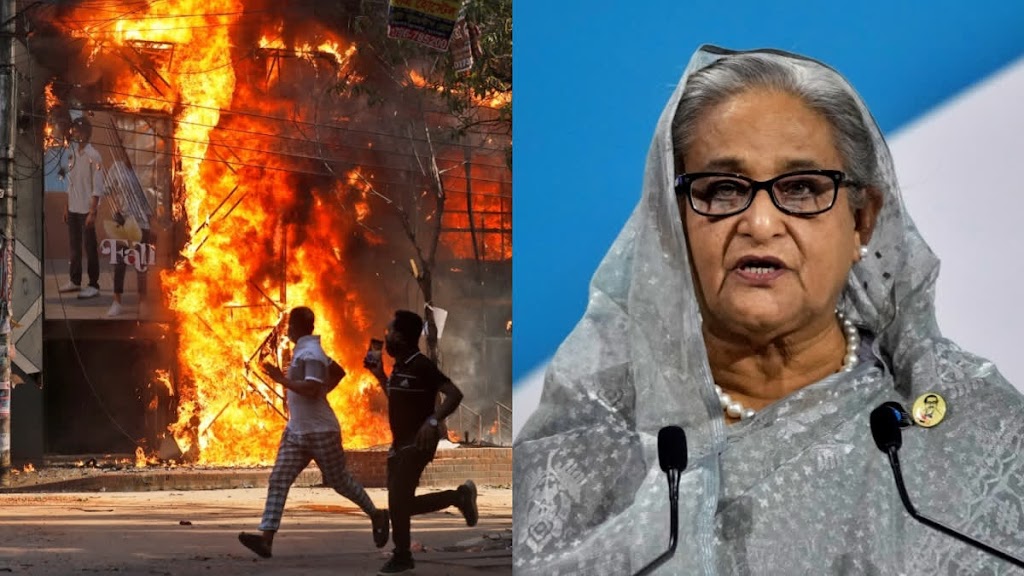What caused the End of the Mughal Empire and the Start of the British Empire in India?
Hello, aspirants are you preparing for UPSC-APSC or any other Govt Exams? If yes, then you must be aware of the most important Indian History Notes for the upcoming competitive exam preparation. Therefore every aspirants need to know the Indian History Notes for APSC Prelims & Mains Exam. In this regard “World_Polity” decides to provide you the most important Indian History notes on Causes of the Downfall of the Mughal Empire for APSC. Infact the Indian History Notes of Mughal Empire that How did British End Mughal Rule in India will be a key topic in the Indian History section for the upcoming exams. So the Indian History notes on Causes of the Downfall of the Mughal Empire for APSC Prelims & Mains Exam will be a pedestrian to crack your exam.
Decline of the Mughal Empire
Factors Responsible for the Decline of the Mughal Empire
In this article we have provided you Indian History the Factors Responsible for the Decline of the Mughal Empire for Assam Public Service Commission. So, read this important Indian history for APSC Prelims as well as other govt exams. These Indian History Notes on Mughal Empire are extremely important and should be a part of your preparation.
Best Indian History Notes for Govt Exams
In order to succeed in the prestigious competitive examination, it is important that the aspirant has access to the Best Indian History Notes. Specially the toppers of UPSC-APSC exams recommend that candidates start their preparation with the Best Indian History Notes for upcoming UPSC-APSC Prelims & Mains Exam.
Indian History GK for APSC
There are mainly four very important Indian History GK on Mughal Empire for APSC Prelims. Mark this general knowledge questions and answers on Indian history for upcoming govt exams :
1. What led to the End of the Mughal Empire?
Ans : The Mughal Empire was in terminal decline since the rise of the Maratha Empire and Sikh Empire. Moreover, internal corruption and costly wars had drained the imperial treasury The killing blow came when following the crushing defeat during the 1857 revolt, Bahadur Shah Zafar, was deposed by the British East India Company and exiled in 1858.
2. Who was the last effective ruler of the Mughal Empire?
Ans : Aurangzeb is known as the last effective ruler of the Mughal Empire. Under him, the Mughal Empire reached its greatest extent, although his policies helped lead to its dissolution.
3. What additional factors led to the decline of the Mughal Empire?
Ans : The causes of the decline of the Mughal Empire can be grouped under: deterioration of land relations, the emergence of regional powers such as the Maratha Empire, the selfish struggle of nobles at the court and lack of initiative in modern weapons.
4. The Mughal Empire came to an end with the death of __________ .
Ans : Bahadur Shah Zafar, also known as Bahadur Shah II, was the last Mughal emperor of India who reigned from 1837 to 1857. The first War of Independence in India started in 1857 under his leadership. After losing the war, he was deposed by the British East India Company and exiled in 1858. He lived there for five years and died at the age of 87, in 1862. His death marked the end of the Mughal Empire.
Causes of the Downfall of the Mughal Empire for APSC : How did British End Mughal Rule in India
The Mughals built one of the greatest empires of their time and had a lasting influence on Indian history and culture. The dynasty was notable for its more than two centuries of effective rule over much of India, for the ability of its rulers, and for its administrative organization. The Mughal emperors notably promoted art and learning. Mughal architecture, in particular, became renowned for its harmony and beauty. However, a number of factors combined to bring on the dynasty’s demise.
Decline of Mughal Empire History
Early modern South Asian Empire the Mughal Empire, also referred to as the Mughal Empire. The empire lasted for two centuries, extending from Kashmir in the north to the highlands of modern-day Assam and Bangladesh in the east, and from the western margins of the Indus basin to the Deccan plateau uplands in south India.
Babur defeated Ibrahim Lodi in the first battle of Panipat, and he later established the Mughal Empire. Thus, a new era and empire began in India, lasting for more than three centuries, from 1526 to 1857. Six famous kings of this dynasty known as the “Great Mughals,” Babur, Humayun, Akbar, Jahangir, Shah Jahan, and Aurangzeb, left their imprint on Indian history.
As the European presence in the Indian Ocean increased and the demand for raw and finished Indian goods increased, the Mughal courts became increasingly wealthier. The Mughal nobles spent more extravagantly, which led to increased support for art, literature, textiles, and architecture, especially under Shah Jahan’s administration. Following Aurangzeb’s passing in 1707, the empire started to fall apart.
The end of Mughal rule in India can be attributed to a combination of factors, including political instability within the Mughal Empire and the expansionist ambitions of the British East India Company. On 21 September 1857, the last Mughal Emperor Bahadur Shah Zafar surrendered to Major William Hodson of the British East India Company’s Army. Bahadur Shah was the rallying point for the sepoys in the Revolt of 1857, and the war was fought in his name as the ‘Emperor of India’
Here’s a brief overview of how the British ended Mughal rule in India :
1. Arrival of the British East India Company : The British East India Company established trading posts in India during the early 17th century. Initially, they focused on trade, but over time, they started acquiring territorial control and expanding their influence.
2. Battle of Plassey (1757) : The Battle of Plassey was a significant turning point in British efforts to establish political control in India. The British, led by Robert Clive, defeated the forces of the Nawab of Bengal, Siraj-ud-Daulah. This victory allowed the British to gain control over Bengal, one of the wealthiest provinces in India.
3. Subsequent Battles and Expansion: Following the Battle of Plassey, the British East India Company continued its military campaigns against other Indian powers. They defeated various regional kingdoms and gradually expanded their territories, including Awadh, Punjab, and the Carnatic region.
4. Treaty of Allahabad (1765) : After their military successes, the British East India Company secured the Treaty of Allahabad with the Mughal Emperor Shah Alam II. Under the treaty, the company obtained the diwani rights, which allowed them to collect revenue and administer the territories of Bengal, Bihar, and Orissa on behalf of the Mughal Empire. This marked a significant shift in power, as the company effectively assumed control over key revenue-generating regions.
5. Decline of Mughal Authority : The Mughal Empire had been in decline for several decades before the British arrived. Weak successors, infighting among nobles, and the fragmentation of regional powers had already weakened the empire’s central authority. The British took advantage of this internal strife and further eroded Mughal influence by establishing their control over various territories.
6. Rebellion and the Last Mughal Emperor : The Indian Rebellion of 1857, also known as the Sepoy Mutiny or the First War of Independence, marked a major challenge to British rule in India. The last Mughal Emperor, Bahadur Shah II, lent his support to the rebellion. However, the rebellion was ultimately suppressed by the British, and Bahadur Shah II was exiled to Burma (now Myanmar).
7. Formal Dissolution of the Mughal Empire : The formal dissolution of the Mughal Empire came in 1858 when the British government abolished the title of the Mughal Emperor and annexed the remaining Mughal territories. The territories were incorporated into British India, marking the end of Mughal rule in India.
8. Economic Diificulties : During Aurangzeb’s reign (1658–1707), the economy of the Mughal Empire began to decline. The heavy taxes he levied impoverished the farming population. At the same time there was a steady decay in the quality of Mughal government. Later emperors showed little desire to govern or to invest their money in agriculture, technology, or the military. Some emperors even discouraged economic prosperity, fearing the wealthy might raise their own armies. Eventually, local leaders rebelled and declared themselves independent from the central government, which hastened the empire’s decline.
9. Size of the Empire and Challenge from Regional Powers : The Mughal Empire had become too large to be controlled by any ruler from one centre i.e. Delhi. The Great Mughals were efficient and exercised control over ministers and army, but the later Mughals were poor administrators. As a result, the distant provinces became independent. The rise of independent states led to the disintegration of the Mughal Empire.
10. Empty Treasury : Shah Jahan’s zeal for construction had depleted the treasury. Aurangzeb’s long wars in the south had further drained the exchequer.
11. Invasions : Foreign invasions sapped the remaining strength of the Mughals and hastened the process of disintegration. The invasions of Nadir Shah and Ahmad Shah Abdali resulted in further drainage of wealth. These invasions shook the very stability of the empire.
12. The Attacks of the Marathas in the North : Peshwa Baji Rao pursued the policy of conquering territories in the North. Gradually, the Marathas occupied large territories in the North and became the strongest power in India. But the Marathas did not replace Mughals and did not assume the responsibility of an Imperial power. Their activities remained limited either to plundering or increasing their sphere of influence. That certainly affected adversely the fortunes of the Mughal Empire.
It is important to note that the decline of the Mughal Empire and the establishment of British rule was a complex process influenced by multiple factors. The British East India Company’s political and military strategies, as well as the internal weaknesses of the Mughal Empire, played significant roles in shaping the outcome.
Indian History Questions and Answers (India GK Quiz)
We hope that the given Indian History Notes for upcoming exams is very helpful and useful at the time of preparation. To get more History notes on India, visit our site www.worldpolity.com
• Must visit : 3000+Indian History MCQ Questions and Answers PDF
UPSC, APSC, SSC, Banking, Railways, Assam Direct Recruitment Grade III and Grade IV Exam, Assam TET, APDCL, DHS, Assam Police is considered as one of the toughest exams and these exams are conducted with tight security. So to grab a job it’s always all about how well you have read & how much revisions you have done. Thank you. Best of Luck.
Now World_Polity is on every platform you can connect with us by just clicking the below social media links. Thank You.
• Subscribe our Youtube channel
• Join our Facebook Page
• Join our telegram Channel
You may also visit :
Well if you like this article on Causes of the Downfall of the Mughal Empire for APSC : How did British End Mughal Rule in India for Assam Competitive Exam, do comment & show your support by sharing it to the other aspirants and if there is any query you are welcome to ask.



